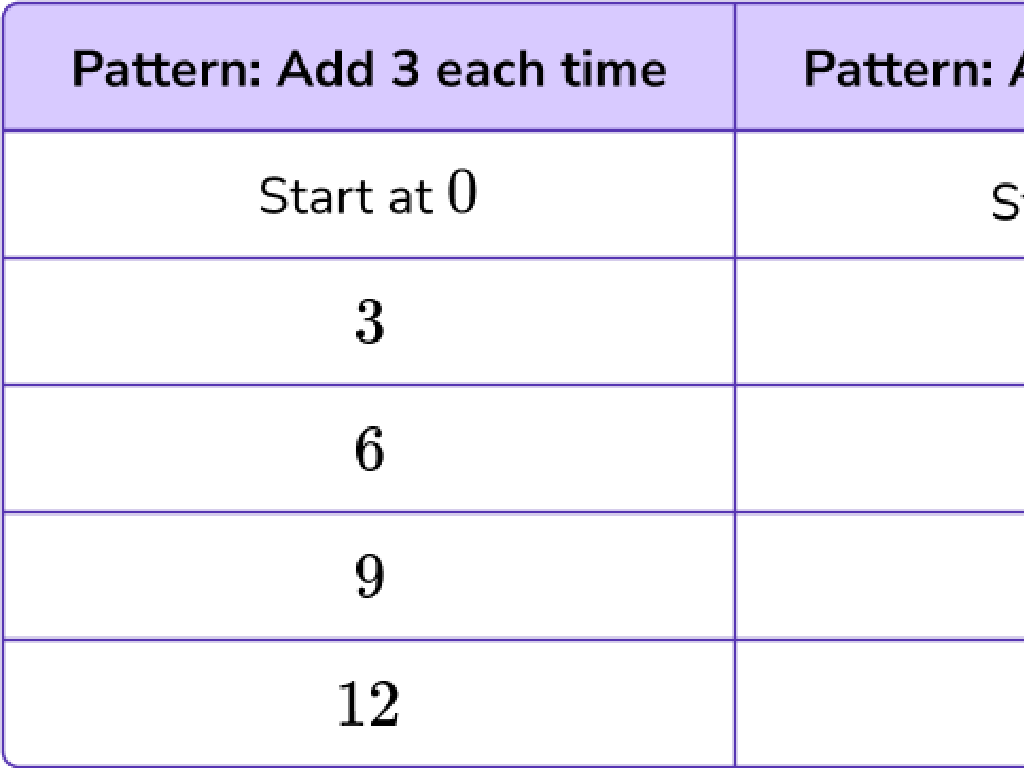Divide By A Power Of Ten With Decimals: Find The Missing Number
Subject: Math
Grade: Fifth grade
Topic: Divide Decimals By Powers Of Ten
Please LOG IN to download the presentation. Access is available to registered users only.
View More Content
Dividing Decimals by Powers of Ten
– Understanding division with decimals
– Division is splitting into equal parts. Decimals are numbers with a point.
– Exploring powers of ten
– Powers of ten have zeros. Like 10, 100, 1000.
– Practical uses of division by powers of ten
– It’s useful for simplifying math problems and understanding place value.
– Finding missing numbers in division
– Use division rules to find unknowns in equations like 4.5 ÷ 10 = ?
|
This slide introduces the concept of dividing decimals by powers of ten, which is a fundamental skill in mathematics. Start by explaining division as the process of splitting a number into equal parts and decimals as numbers that contain a decimal point. Then, introduce powers of ten, emphasizing the pattern of zeros. Discuss the practicality of this skill in simplifying complex math problems and understanding place values. Finally, demonstrate how to apply these concepts to find missing numbers in division problems, ensuring to provide examples and encourage students to practice with similar problems.
Dividing Decimals by Powers of Ten
– Define a Power of Ten
– A number like 10, 100, 1000 where 10 is raised to an exponent
– Examples: 10, 100, 1000
– 10^1=10, 10^2=100, 10^3=1000 show increasing powers
– Multiplying effects on numbers
– Multiplying by 10 shifts digits left, making numbers larger
– Dividing decimals by 10, 100, 1000
– Dividing by 10, 100, 1000 shifts digits right, reducing value
|
This slide introduces the concept of powers of ten and their impact on numbers, specifically when dividing decimals. Begin by defining a power of ten as 10 raised to an exponent, which determines how many zeros follow the one. Show examples of powers of ten to illustrate the pattern. Explain that multiplying by powers of ten shifts the digits to the left, increasing the number’s value, while dividing by powers of ten shifts the digits to the right, decreasing the value. Use visual aids like number lines or place value charts to help students visualize the shift. Provide practice problems where students divide decimals by 10, 100, and 1000 to find the missing number, reinforcing the concept that the decimal point moves to the left with each power of ten.
Dividing Decimals by 10
– Shift decimal point left for ÷10
– Moving one place left makes the number 10 times smaller.
– Example: 5.6 ÷ 10 = 0.56
– 5.6 becomes 0.56 when the decimal moves one place to the left.
– Practice: 3.4 ÷ 10 = ?
– What does 3.4 become when we apply the same rule?
|
This slide introduces the concept of dividing decimals by 10, which is a fundamental skill in understanding place value and decimal operations. Emphasize that when dividing by 10, the decimal point moves one place to the left, effectively making the number 10 times smaller. The example provided should help illustrate this concept. For the practice problem, guide students to apply what they’ve learned from the example to solve it. Encourage them to explain the process in their own words to deepen their understanding. This activity will help solidify their grasp of how division by 10 affects decimal numbers.
Dividing Decimals by 100
– Shift decimal point left for division
– Move two places for dividing by 100
– Example: 7.25 ÷ 100 = 0.0725
– Starting with 7.25, move the decimal left two spots to get 0.0725
– Practice: What’s 8.9 ÷ 100?
– Try moving the decimal yourself to find the answer
|
This slide introduces the concept of dividing decimals by 100. Emphasize to students that when dividing by a power of ten, such as 100, they can simply move the decimal point to the left by the number of zeros in the power of ten. In this case, two zeros mean two places to the left. Use the example to show this visually, and then provide the practice problem for students to attempt on their own. Encourage students to visualize the decimal hopping over two places to the left and ensure they understand that each hop represents a division by 10. After the practice problem, discuss the solution as a class.
Dividing Decimals by 1000
– Shift decimal point left 3 places
– Example: 2.345 ÷ 1000
– 2.345 becomes 0.002345 after division
– Practice: 6.78 ÷ 1000
– Apply the same rule: What’s the result?
– Remember the rule of three zeros
– Each zero in 1000 moves the decimal one place left
|
When dividing a decimal by 1000, we move the decimal point three places to the left, as 1000 has three zeros. This is a simple way to divide without complex calculations. For example, 2.345 ÷ 1000 shifts the decimal to 0.002345. Provide students with the practice problem 6.78 ÷ 1000 and ask them to apply this rule. Remind them that for every zero in the divisor (1000), the decimal point moves one place to the left. This slide will help students visualize the process of division by a power of ten and reinforce their understanding through practice.
Dividing Decimals by Powers of Ten
– Recognize division patterns
– Moving the decimal left for each power of ten
– Apply knowledge to find missing numbers
– Use the pattern to solve for unknowns
– Example: 4.8 ÷ ? = 0.048
– What power of ten makes 4.8 become 0.048?
– Practice with similar problems
|
This slide aims to solidify the students’ understanding of how dividing by powers of ten affects decimal numbers. Emphasize the pattern that occurs when dividing by 10, 100, 1000, etc., which is essentially moving the decimal point to the left by one place for each power of ten. Use the example provided to illustrate this concept, showing that to turn 4.8 into 0.048, we need to divide by 100 (or 10^2), as it involves moving the decimal two places to the left. Encourage students to practice with additional problems, finding the missing power of ten that would result in the given answer. This will help them grasp the concept of division by powers of ten with decimals and how to find missing numbers in such equations.
Class Activity: Division Detective
– Discover the missing power of ten
– Pair up for problem-solving
– Divide decimals by powers of ten
– For example, 500 ÷ 10^? = 5. What is the missing exponent?
– Present solutions to the class
|
This activity is designed to encourage collaborative learning as students work in pairs to solve division problems involving decimals and powers of ten. Provide a set of problems where students need to find the missing exponent that represents the power of ten. After solving the problems, each pair will share their answers with the class, fostering a discussion on different methods used to find the solution. Possible activities include: 1) Matching games with mixed problem cards, 2) ‘Division Detective’ where one student writes a problem and the other finds the missing number, 3) Timed challenges to solve as many problems as possible, 4) Creating a ‘Division Wall’ where students post their solved problems for others to see.
Review and Practice: Division by Powers of Ten
– Recap of dividing decimals by 10, 100, 1000
– Remember, moving the decimal left for each power of ten
– Group activity with missing numbers
– Work together to solve problems like 4.5 ÷ 10 = ? or 0.03 ÷ 100 = ?
– Individual worksheet practice
– Solve similar problems independently to master the concept
– Reinforce learning with examples
|
This slide is aimed at reinforcing the day’s lesson on dividing decimals by powers of ten. Begin with a brief recap, highlighting the rule of moving the decimal point to the left one place for each power of ten (e.g., ÷ 10 moves one place, ÷ 100 moves two places). For group practice, present challenges where students work together to find missing numbers in division equations. Provide a worksheet for individual practice, consisting of problems that require students to divide decimals by 10, 100, and 1000. Encourage students to explain their reasoning and methods to the class to solidify their understanding. The goal is to ensure that by the end of the practice, each student is comfortable with the concept and can apply it confidently.
Homework: Mastering Division by Powers of Ten
– Complete worksheet on division by powers of ten
– Focus on problems involving decimals and powers of ten
– Get ready for a quick quiz next class
– Review today’s lesson to prepare for the quiz
– Practice with additional problems at home
– Extra practice helps reinforce what you’ve learned
|
This homework assignment is designed to reinforce the concepts taught in class about dividing decimals by powers of ten. The worksheet will provide structured practice, while the upcoming quiz will help assess their understanding of the topic. Encourage students to practice extra problems at home to build their confidence and mastery. As a teacher, be prepared to review the homework in the next class and provide additional examples or clarification as needed. Offer support for students who may need extra help and consider providing a list of resources or websites where they can find more practice problems.





